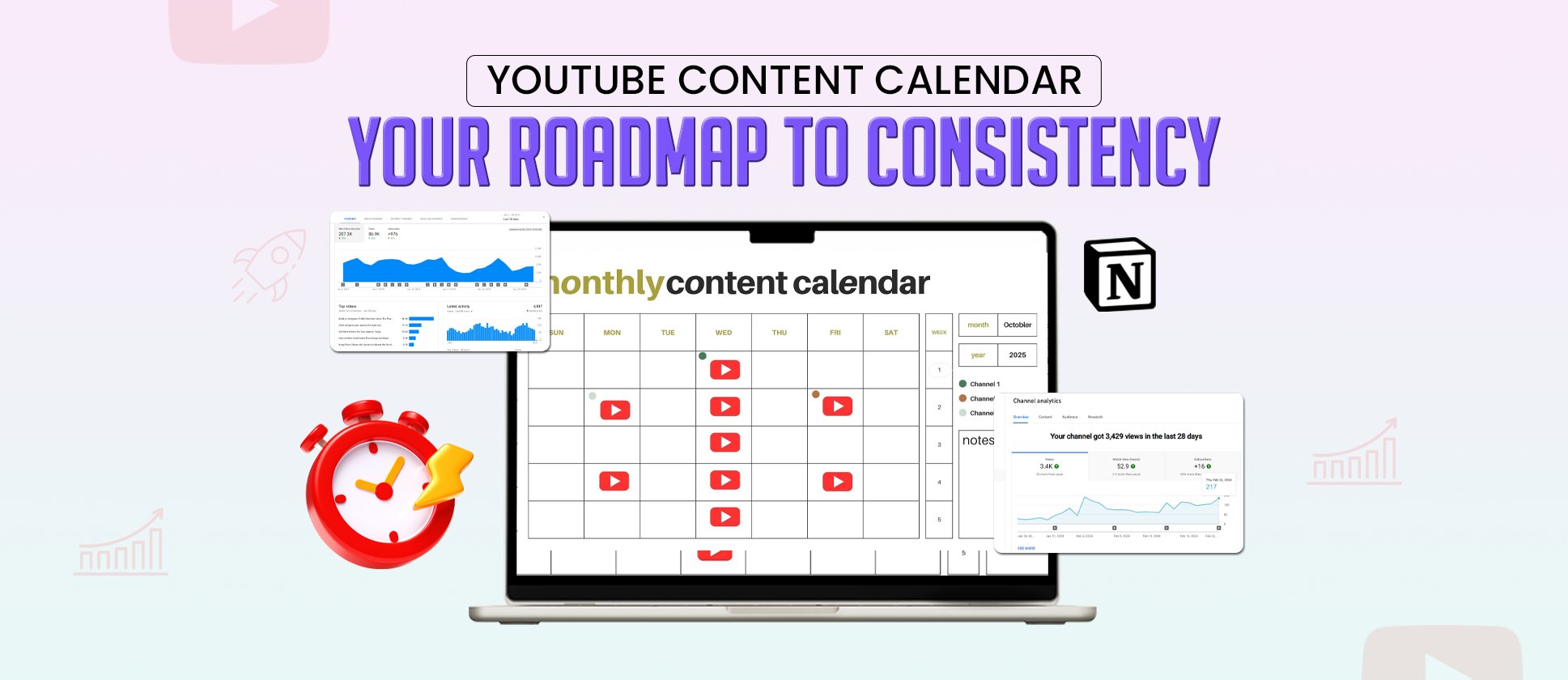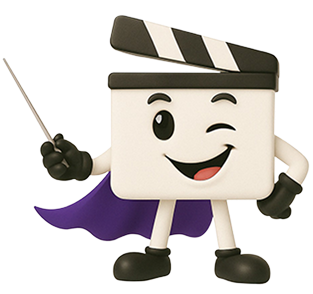Quick Summary
TL;DR: A YouTube Content Calendar helps creators stay organized and consistent with video uploads. By planning content ideas, formats, and promotional strategies, you can grow your channel, engage your audience, and align videos with marketing goals or trends. #tldr
- Core Focus:
Goals → Audience → Frequency → Formats → Ideas → Key Dates → Tools → Workflow → Optimization → Analytics
- Key Steps:
Define your goals and understand your audience → Decide on posting frequency and mix of video formats (Shorts, tutorials, vlogs, reviews, livestreams) → Brainstorm and organize content ideas using trends, competitor research, and keyword tools
- Main Takeaway:
A content calendar transforms video creation from guesswork into a repeatable, data-driven process. In this blog, you can find a complete guide to creating a YouTube Content Calendar to get more engagement.
If you have ever uploaded videos without a regular schedule, you might have found it hard to keep your audience engaged. Views can go up and down unpredictably, which makes it hard for subscribers to know when to expect new content. The YouTube algorithm does not always help with your efforts, either. You need to use the YouTube Content Calendar as it helps you bring order to the chaos by organizing ideas, formats, and publishing dates so your channel grows with consistency instead of guesswork.
Consistency matters more than most creators realize. According to YouTube’s own Creator Academy, channels that upload on a regular schedule see stronger audience retention and algorithmic support compared to those that post at random intervals. A calendar ensures that every upload has a purpose, whether you’re publishing Shorts for engagement or long-form tutorials designed to rank higher on YouTube.
For brands and businesses, a content calendar is more than just a schedule for posting videos. It links your video plans to marketing campaigns, product launches, and seasonal trends. This helps teams work together better, makes planning easier, and keeps you focused on your growth goals. Instead of rushing for last-minute ideas, you’ll always know what to expect next and why it is important.
What is a YouTube Content Calendar?
At its core, a YouTube Content Calendar is simply a planning system that keeps your channel organized. Instead of scrambling for ideas at the last minute, you have a clear roadmap showing what videos are coming up, when they’ll be published, and how they fit into your bigger goals. Think of it as a guide that makes creating content feel less overwhelming and a lot more intentional.
A solid calendar usually includes a few key pieces.
- Content ideas so you’re never stuck staring at a blank page
- Formats like Shorts, tutorials, vlogs, reviews, or livestreams to keep your channel balanced
- Publishing dates that help you stay consistent with uploads
- Collaboration details if you’re working with editors, designers, or guest speakers
- Promotion strategy so your videos get seen beyond YouTube itself
This system is awesome because it works for everyone. If you’re a solo creator, it helps you keep on track. If you’re part of a content creation team, it makes working together easier since everyone knows what they need to do and when. In both cases, a calendar turns video creation into a repeatable process instead of a guessing game.
Benefits of a YouTube Content Calendar
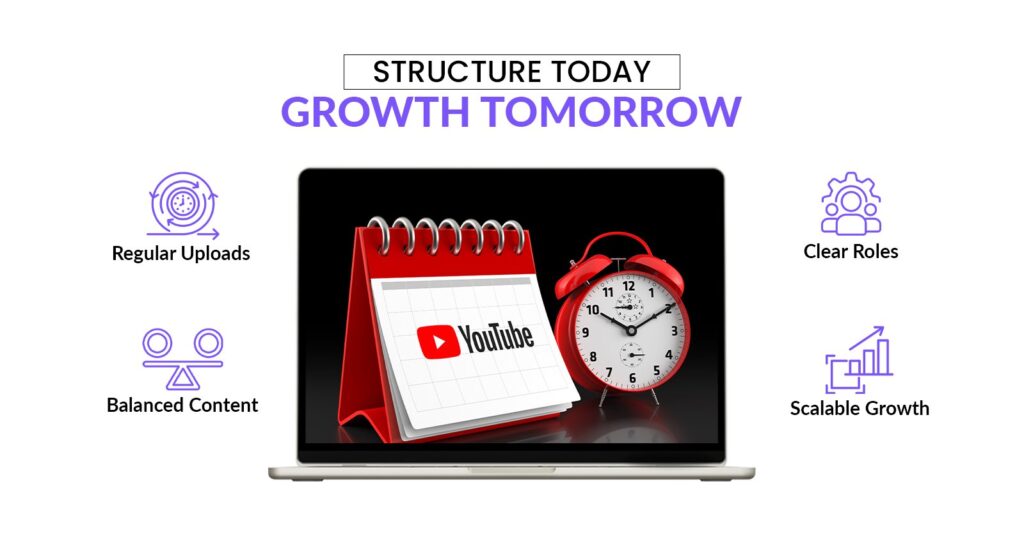
Many creators struggle to maintain a regular upload schedule. If videos are uploaded irregularly, viewers may lose trust, and YouTube’s algorithm might not support unpredictable channels. A good way to solve this problem is to use a YouTube content calendar. This tool creates a clear schedule for your uploads, allowing your audience to know when to expect new videos.
Another major advantage is collaboration. If you’re working with scriptwriters, editors, designers, or a publishing team, a calendar keeps everyone aligned. Instead of last-minute confusion, each person knows their role and deadline.
It also helps you bring variety to your channel. Without a plan, you might default to the same format over and over. A calendar makes it easier to balance Shorts, tutorials, reviews, or live streams so your content stays fresh.
From a business perspective, a calendar ensures your videos line up with launches, seasonal events, or campaigns. When you tie your calendar to YouTube Analytics, you can make smarter choices about what to create next, based on real data.
Here’s a quick look at how a content calendar compares to random posting.
| Aspect | –Random Posting | Content Calendar Approach |
|---|---|---|
| Consistency | Irregular uploads | Regular, predictable publishing |
| Collaboration | Disorganized handoffs | Clear roles & deadlines |
| Content Variety | Risk of repetition | Balanced formats & topics |
| Growth Potential | Slow & unpredictable | Scalable with audience insights |
Step-by-Step Guide to Create a YouTube Content Calendar
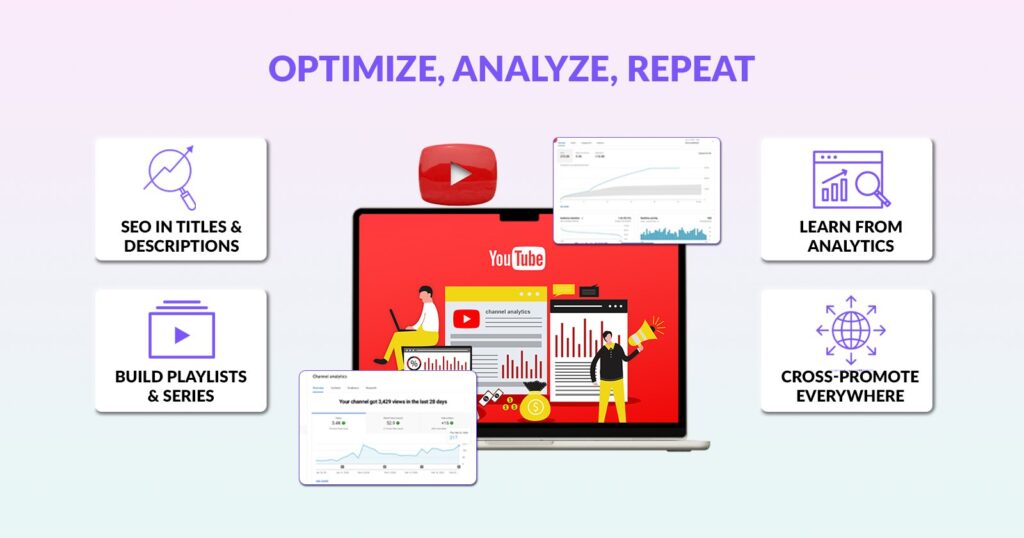
A YouTube content calendar helps guide your channel’s direction. A content calendar helps you plan your new videos in advance. This way, you won’t have to rush for ideas the night before a video is due. It helps you maintain consistency and deliver the kinds of videos your viewers genuinely look forward to watching. With this structure, it becomes easier to get YouTube views and grow your channel steadily over time.
Planning also aligns with what industry research shows. According to Think with Google, 90% of people say they discover new products or brands through YouTube. That means if you treat your publishing schedule seriously, you’re building visibility and trust.
Let’s walk through the steps to create a calendar that works for you.
Step 1 – Define Goals and Audience
Before you start filling in dates, it’s important to know what you’re aiming for. Not every channel has the same objective, so your calendar should reflect your bigger picture.
Here are some common goals.
- Entertainment – Keeping viewers engaged with fun, binge-worthy content.
- Education – Sharing tutorials, how-tos, or explainer videos.
- Marketing – Supporting a brand or product launch with consistent video promotion.
- Sales enablement – Creating videos that help move prospects closer to a purchase.
Just as important is understanding your audience. Spend time looking at demographics such as age, location, and interests inside YouTube Analytics. Consider their pain points, what they struggle with, and how your videos can address those issues. Knowing your audience helps you create a personalized calendar.
Step 2: Decide on Content Frequency and Formats

When planning your channel, the first thing to decide is how often you will post. Some creators like to upload daily, while others find it easier to post once a week. What matters most is not how frequently you publish, but whether you can stick to your schedule over time. If you set a pace that works for you, your audience will quickly learn when to check in for new videos.
The next thing to think about is variety. Sticking to just one type of video can make your channel feel repetitive. Mixing formats, long-form or short-form videos, keeps things fresh and gives your viewers more ways to connect with what you share. Here are a few options you might want to include in your calendar.
- Shorts – They are quick hits that grab attention fast
- Tutorials – Provide step-by-step guides that teach something useful
- Reviews – Take honest takes on products, tools, or services from the audience
- Vlogs – Detailed story engages your audience with you and your product
- Interviews – Do chats with guests who bring new voices and ideas
- Livestreams – Hold real-time sessions where you can talk directly with your audience
Some creators lean heavily on Shorts, others thrive with long tutorials, and plenty mix it all together. The trick is finding a balance that works for your goals and feels natural to your viewers.
Step 3: Brainstorm and Organize Content Ideas
Once you know how often you want to post, it’s time to fill your calendar with ideas. A good mix of creativity and research works best here. Look at what similar channels are doing, study current YouTube trends, and use keyword tools to spot what people are actively searching for.
Some helpful methods include.
- Competitor Research: see which videos in your niche are performing well.
- Keyword Tools: find terms people are using when looking for content.
- YouTube Trends: stay updated on trending topics your audience already cares about.
For tools, Google Trends, TubeBuddy, and vidIQ can all give you valuable insights. They help you spot high-performing topics and organize your list of ideas so nothing goes to waste.
If you want to take this a step further, plan ideas around performance data. Using metrics to guide your strategy is a smart way to avoid guesswork. For example, tracking viewer behavior and engagement can highlight which topics are worth expanding on.
Step 4: Map Ideas to Key Dates and Events
After you’ve gathered your content ideas, the next step is to figure out when they should go live. Posting at the right time can give your videos an extra push. Do you have an upcoming campaign, a new product launch, or a special event on the horizon? Lining up videos with those moments makes your channel part of the conversation and gives viewers a reason to tune in right when it matters most.
Keep in mind holidays, seasonal shifts, or industry events that your audience already follows. These moments are natural hooks that make your videos feel more relevant and timely.
And don’t forget trending topics. If something connected to your niche starts gaining attention, adding a quick video on that subject can give your channel a nice boost while people are searching for it. Planning gives you a framework so you can stay flexible without scrambling.
Example YouTube Content Calendar (One Month)
| Week | Key Dates / Events | Video Idea | Format | Notes |
|---|---|---|---|---|
| Week 1 | New Year Campaign | Top 5 Tools to Kickstart 2026 | Tutorial | Tie into seasonal productivity trends |
| Week 2 | Industry Webinar | Behind the Scenes: What We Learned | Vlog | Align with live event |
| Week 3 | Product Launch | Unboxing + Feature Walkthrough | Review | Sync with marketing push |
| Week 4 | Trending Topic | Reacting to the Latest Viral Challenge | Shorts | Fast turnaround for trend relevance |
Step 5: Choose Tools to Build Your Calendar
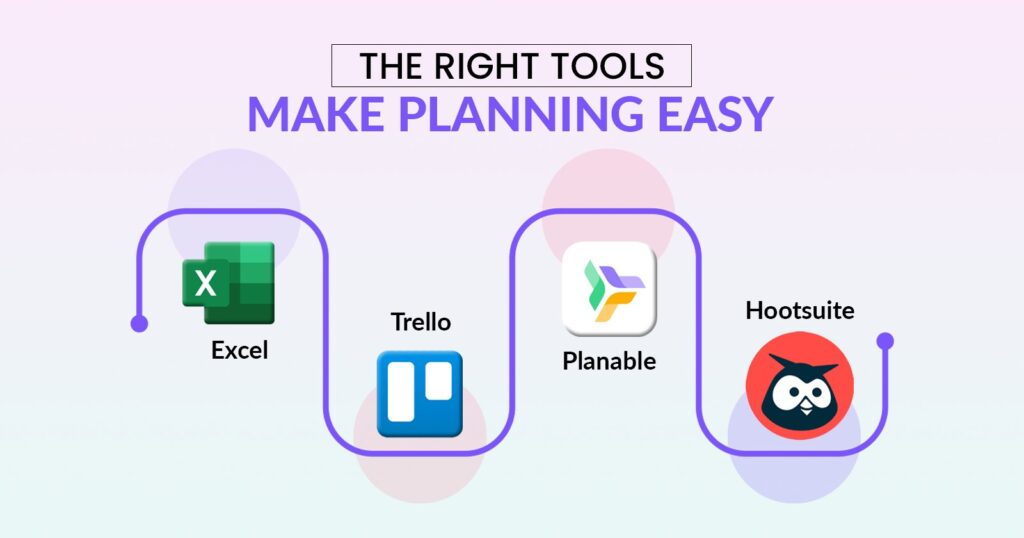
Your content calendar can be as simple or advanced as you like. Some prefer a basic spreadsheet, while others use project management tools or social media planners for scheduling and collaboration. Choose a tool that is easy for you and your team to use daily.
Here’s a comparison of popular tools people use to build their YouTube content calendars:
| Tool | Key Features | Typical Monthly Cost | Best For |
|---|---|---|---|
| Google Sheets or Excel | Simple, highly customizable; free templates. | Free | Solo creators or people doing everything themselves. |
| Trello | Visual boards, drag & drop task status, easy collaboration. | Free up to ~$10/user for premium features. | Small teams or creators who like visual workflows. |
| Planable | Collaboration, approvals, and calendar views across channels. | Starts from $33/workspace/month for the Basic paid plan. (help.planable.io) | Agencies or teams needing approval workflows. |
| Hootsuite | Scheduling across socials, analytics, content calendar, and team roles. | $99/month for Professional plan (annual billing), $149/month billed month-to-month. (OnlySocial) | Bigger teams or brands managing multiple social accounts. |
| FeedHive | AI-powered scheduling suggestions, multiple workspaces, and social inbox. | €19/month (Creator) up to €299/month (Agency). (feedhive.com) | Creators scaling up or managing multiple brands/projects. |
Note: Prices are approximate as of this update and may vary with promotions, annual billing discounts, or regional pricing. Always check the provider’s official site before making a purchase.
Using this table, you can decide which tool matches your budget, team size, and how much collaboration or flexibility you need.
Step 6: Plan for Collaboration and Workflow
A good content calendar is not just about dates and topics, it is also about people. Everyone involved in your YouTube process should know what part they play and how the work moves from one step to the next. Laying this out clearly saves time and avoids confusion.
Here are some common roles you might assign.
- Scriptwriter
- Editor
- Designer
- Publisher
- Social Manager
Now, let’s put this into action with a simple workflow example.
- The scriptwriter drafts the outline and shares it with the team.
- The editor reviews the footage, adds the final touches, and uploads the edited version.
- The designer steps in to create a thumbnail and any supporting visuals.
- The publisher schedules the video on YouTube and makes sure the title, tags, and description are in place.
- Finally, the social manager promotes the video across other platforms and engages with comments once it goes live.
Feedback and approvals can happen at each stage, but it’s best to keep the process clear and light. For example, you might decide that only one person gives the final approval to avoid delays. A simple checklist or shared board can help everyone see what stage a video is in and what comes next.
Step 7: Schedule, Publish, and Optimize
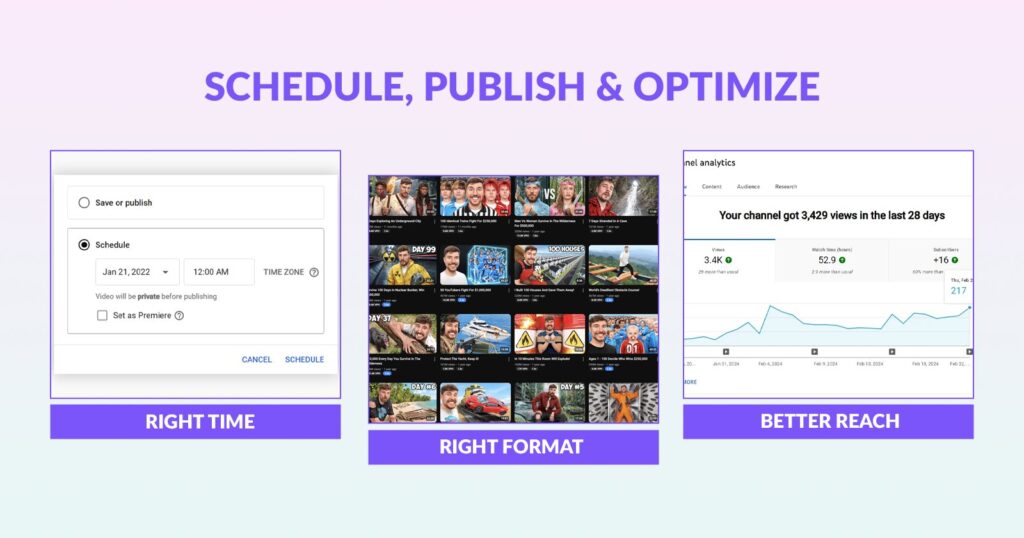
Figuring out when to publish is part art, part science. Selecting good times helps your video get in front of more people right when they’re ready to watch.
Here are a few things to keep in mind:
- Use data from studies to guide you. For example, a SproutSocial insight shows that 1 p.m. (local time) is a strong time to post most days, especially Monday through Thursday.
- Also, check reports like one from HubSpot that say posting between 6 and 9 p.m. or 12 to 3 p.m. tends to work well.
Next, think about how this changes depending on the format. Shorts can perform well when they’re published during high-traffic windows or times when people casually scroll. Long-form content often does better when people have more time – afternoons or evenings usually work.
Then there are optimization details that really matter:
- Thumbnails that promise something interesting and look good even at small sizes
- Calls-to-action: a timely ask to subscribe, comment, or check another video or playlist
- Metadata: titles, descriptions, tags filled out well so YouTube understands what the video is about and can serve it to the right viewers
Putting all this together, you get something like this: plan ahead, choose your format (Shorts or long format), upload at a time that matches when your audience is active, and make sure the elements around your video help it get discovered and appreciated.
Step 8: Monitor, Analyze, and Adjust
Once your videos start rolling out, the real work begins, seeing what’s actually working. A content calendar isn’t something you set once and forget. It’s a living document that gets sharper every time you learn from the numbers.
YouTube Analytics is your best friend here. Open your dashboard and pay attention to a few key metrics:
- Click-through Rate (CTR): This metric indicates how many people clicked your video after viewing the thumbnail or title. If CTR is low, it may be time to test new thumbnail designs, tweak your titles, or try a different opening hook.
- Watch Time: This shows how long people are sticking around. Longer watch times signal that viewers are engaged, which also helps your video get recommended more often.
- Unique Viewers: This tells you how many different people are watching, giving you a clear sense of reach beyond repeat views.
Here’s an example. Let’s say you post a new tutorial and notice the CTR is strong, but the watch time drops halfway through. That tells you the thumbnail and title are working, but the content pacing might need improvement. You can use that insight to plan your next tutorial with tighter editing or a stronger hook in the middle.
On the other hand, if you notice vlogs are pulling in fewer unique viewers compared to Shorts, you might reduce the number of vlogs in your calendar and lean into formats that expand your reach.
If you want to go deeper, you can explore broader insights like those covered in our guide on Top Marketing Metrics to Track. Pairing YouTube Analytics with these benchmarks will help you see how video performance ties into your bigger marketing picture.
YouTube Content Calendar Template (Downloadable/Example)
Sometimes it helps to see what a working calendar actually looks like. A simple template can give you a clear picture of how ideas move from brainstorming to publishing. The goal isn’t to overcomplicate things but to keep everyone (or just yourself, if you’re a solo creator) on the same page.
Here’s an example of a weekly content calendar you could set up:
| Idea/Topic | Format | Script Deadline | Shoot Date | Editor Assigned | Upload Date | Status |
|---|---|---|---|---|---|---|
| Product Demo | Tutorial | 10-Sep | 12-Sep | Editor A | 14-Sep | Draft |
| Q&A Session | Live | 15-Sep | 18-Sep | Editor B | 20-Sep | Planned |
| Quick Tips | Shorts | 17-Sep | 18-Sep | Editor A | 19-Sep | Scheduled |
This is just one way to organize things. You can adjust the columns based on what matters most for your workflow, for example, adding a column for keywords, promotional notes, or target platforms if you repurpose content.
Optimizing Your YouTube Content Calendar for Growth
Creating a content calendar is a strong first step, but the real magic happens when you fine-tune it for growth. A calendar should be more than dates on a page, it should act like a strategy guide that helps you get the most from every video you publish.
One way to do that is by thinking about YouTube SEO from the start. Simple things like weaving relevant keywords into your video titles, descriptions, and even hashtags can help your content show up in search and suggested feeds. The more discoverable your videos are, the easier it becomes to reach new viewers.
Your calendar should also be flexible enough to reflect what you’re learning from YouTube Analytics. For example, if you notice that tutorials consistently hold better watch time than vlogs, plan more tutorials in the upcoming weeks. Over time, this kind of data-driven planning helps you shape a content mix that keeps your audience engaged.
Another smart move is building playlists or mini-series around your strongest topics. Instead of one-off videos, connect them into a flow that encourages viewers to keep watching. This not only increases total watch time but also makes your channel feel more like a resource library.
Finally, think beyond YouTube itself. Your videos can gain more traction if you share them across social media, embed them into blog posts, or include them in your email campaigns. Adding these steps to your calendar ensures each video gets the visibility it deserves.
Major Mistakes to Avoid When Creating a YouTube Content Calendar

A content calendar is meant to make life easier, not harder. Still, many creators fall into the same traps that limit growth instead of supporting it. The good news is, once you know what to watch out for, these mistakes are easy to avoid.
Here are some of the most common downsides:
- Unrealistic schedules – Trying to post daily when you don’t have the resources can lead to burnout and lower-quality content.
- Overlooking Shorts and trending formats – Focusing only on long-form videos can mean missing out on quick wins and broader reach.
- Misaligned goals with your brand – If your calendar doesn’t support your bigger vision, whether that’s brand awareness, sales, or community building, it won’t deliver the results you want.
- Forgetting to update with performance insights – A calendar shouldn’t be static. Using YouTube Analytics to adjust your plan keeps your strategy relevant and effective.
By keeping these in mind, you’ll create a calendar that supports steady growth without overwhelming you or your team.
Conclusion
A YouTube content calendar works best when it strikes the right balance between structure and creativity. It helps you stay consistent without boxing in your ideas. Start small, test what works, and build for your channel. If you’d rather skip the trial and error, you can hire ShortVids services to manage your video content strategy and keep your channel growing consistently.
FAQs About YouTube Content Calendars
A content calendar keeps your uploads consistent and organized. Instead of scrambling for ideas, you’ll always know what’s coming next, which helps both your audience and the YouTube algorithm trust your channel.
It depends on your goals and capacity. Some creators post once a week, while others upload multiple times. The key is to find a schedule you can sustain without burning out, even if that means starting with one video per month.
Popular choices include Google Sheets for simple tracking, Trello or Asana for team collaboration, and tools like Planable or Hootsuite for managing approvals and promotions.
Start by defining your goals, then plan formats, brainstorm ideas, and map them to key dates. From there, use a spreadsheet or project management tool to schedule script deadlines, filming, editing, and publishing.
Yes. Google Sheets offers free calendar templates that you can customize for your YouTube needs. It’s a great starting point if you’re just getting into planning.
You can use ChatGPT to brainstorm content ideas, organize video topics into themes, or draft a basic posting schedule. Once you have the ideas, you can transfer them into tools like Sheets or Trello to keep everything on track.
A content calendar is a schedule that details what content will be published, where, and when. Meanwhile, a content plan outlines the strategy behind it, including the purpose of the content, the target audience, and the intended goals.
Book a Call Today
- Fixed monthly plans starting at $999
- 24-hour turnaround time (or less) on all short-form edits
- 3-layer quality check system on every video
- No more chasing freelancers or managing editors
- Scale up to 50+ videos/month without hiring in-house
- Content team trained on platform trends, scroll-stopping hooks & storytelling
- Fully managed by professionals – you just upload & approve
- Response time: Under 1 hour (US & GCC time zones)
Cut your production costs, not your standards.

